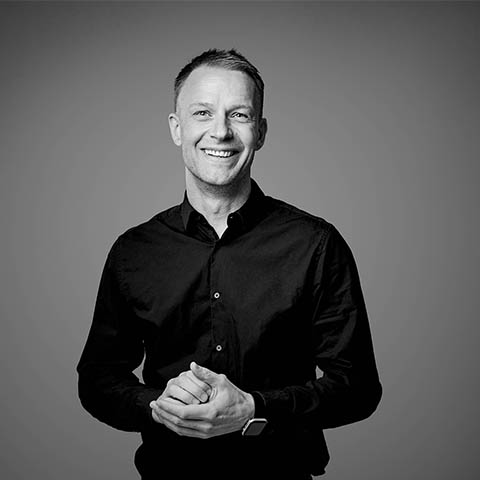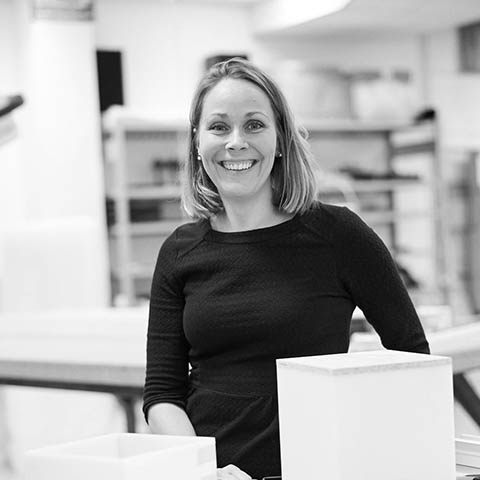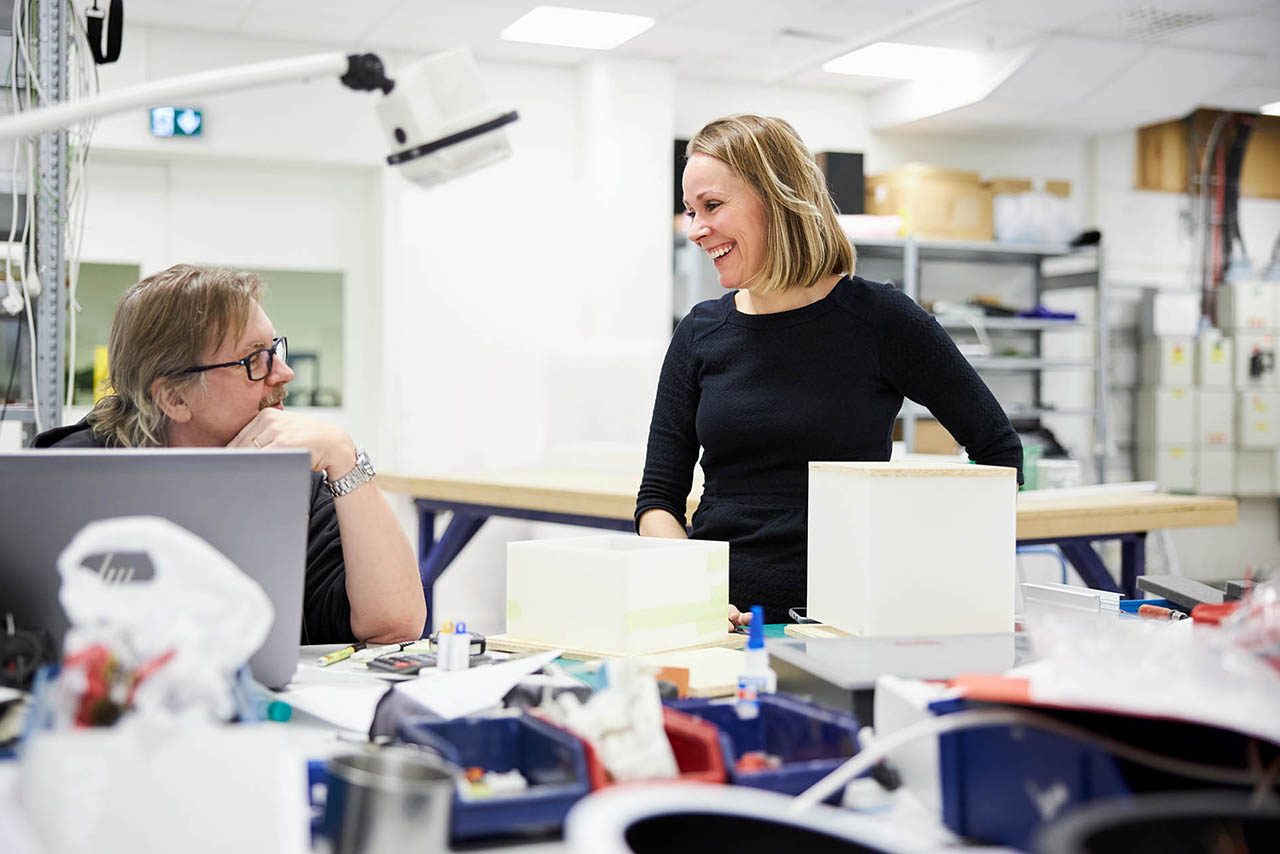
The waste is the win - making your carbon footprint tip-toe
Sustainability and environmental awareness are (thankfully) on everyone’s agenda these days. And for real change to happen, we all need to make new choices. Meet some of the people at Fagerhult, that has challenged themselves into thinking outside the box, resulting in - a little box.
Fagerhult has been a manufacturing company for over 75 years. Throughout this time, we have always been careful with details and quality. But, what was right and real in 1945 is no longer an undisputable fact. In 2020 we started a rigorous sustainability work, with goals linked to the UN's global goals for sustainable development, to provide direction for our journey.
Among other things, we want our luminaires to consist of 80% renewable or recyclable materials before 2030. Multilume Re:Think, made of Solid Board, an entirely new material for the industry, is one step on that journey. Here you meet some of the people behind it.
OUR FRIENDS, AND OUR FRIEND’S FRIEND
But, where to start when you are a producing factory facing a challenge as big as this? Elin Stjernholm, R&D Manager at Fagerhult, explains.
– Well, first up we´ve started to introduce our suppliers to our ambitions in 2030 - how can we reach this quite ambitious goal together? We got a more in-depth knowledge about our suppliers; where their material comes from, which energy they use in their production and so on. But we did not stop there- the suppliers supplier was also of huge interest for us.
Parallel to the external sustainability check with the suppliers, Elin describes that there was also an internal process at Fagerhult.
– To get the big picture we made a life cycle analysis* for some of our products, Elin Stjernholm says. It was to clarify how big impact the material had, since we already knew that it mattered. We´ve always optimized the material in our products and made conscious choices, and moving towards more sustainable materials feels both natural and necessary. On top of this, we´ve also started projects with different universities in Sweden, focusing on sustainable materials.
 "One of the first times we showed it, one of the reactions was “is that a pizza box or what is it?" Martin Bååth, design engineer
"One of the first times we showed it, one of the reactions was “is that a pizza box or what is it?" Martin Bååth, design engineer
PAPER PLANES AND PIZZA BOXES
So, in order to put the knowledge into practice, the design engineers at Fagerhult got together for their reoccurring innovation forum to come up with new ideas. Martin Bååth, design engineer at Fagerhult, describes:
– The team and I started to brain storm and asked ourselves – would it be possible to change the material in a recessed flatpanel, our Multilume Slim? It is one of our high runners, and already a very good luminaire, so it would be quite a challenge. We reached out to one of our suppliers, and started to discuss how it could be done. Together we did some prototypes in different materials, until we found a material that would be suitable for this luminaire.
Even though it was the sort of innovation that the team was looking for, it was not an immediate hit for everyone.
– I remember one of the first times we showed it, and the reaction was “is that a pizza box or what is it?”, Martin says with a laugh. But most of all, my co-workers had an open mindset regarding this paper experiment, and it was exciting to continue the development process.
MAKING THE (PAPER) CUT
Since this material was totally new to all the members in the project, it raised new questions for the team to handle. Would it be safe? Would the luminaire break during installation? Is it possible to develop a luminaire in paper, without compromising with the light quality?
– Given that this material is organic, it behaves completely different compared to the dead materials that we are used to, such as steel and plastic, Martin Bååth explains. We needed to investigate thoroughly how the material would react to temperature shifts and moisture. Would it shift form or shape because of it? That material tolerance was something we needed to include in the design.
– Never have we tested so much, as on this one, says Martin Bååth with a smile. This material has cleared all tests that we need to perform, according to branch standards. It has really been a journey, and we have learned so much by bringing in a new material. Our supplier has been so helpful in learning us understand the whole chain. We have aquired a great in-depth knowledge on what we can do with this material, and it’s not only for packaging industrial. You can do so much more. For an example a very good flat panel.
 "There is a lot of interesting investigations going on, and sustainability is certainly in the air." Elin Stjernholm, R&D manager, Fagerhult
"There is a lot of interesting investigations going on, and sustainability is certainly in the air." Elin Stjernholm, R&D manager, Fagerhult
NO MORE PLASTIC IN 2030?
But how will the future look, will we all have paper luminaires at home in 20 years?
– Well, we are just getting started, says Elin Stjernholm. It might be a luminaire with a lot of renewable- and recycled material. Or maybe, if we let ourselves think out of the box, which in important in this stage, there will be a technical plastic with no oil offered on the market. Maybe we can reduce so much material that the focus is just on the light source and its distribution, or perhaps can we take it all the way? Reused luminaries with light as a service? There is a lot of interesting investigations going on, and sustainability is certainly in the air.
* A life cycle assessment is an overall calculation of a luminaire's environmental impact during different stages of its life - such as manufacturing, distribution, usage, recycling etc.
If you wish to learn even more on Multilume Re:Think, you find the campaign site here.
TEXT MARIA VÅRENIUS
PHOTO PATRIK SVEDBERG
Related News

Innovación en cada pliegue: Wrapped va más allá de la brillantez en la ingeniería
Dado que la sostenibilidad ya no es una elección sino una necesidad, la innovación debe comenzar con la pregunta: ¿Qué pasaría si hiciéramos las cosas de otra manera? Para el equipo de I+D de Fagerhult, esa pregunta se convirtió en la chispa detrás de Wrapped, la primera luminaria suspendida del mundo hecha de cartón. Tradicionalmente, las luminarias suspendidas se fabricaban con armazones metálicos, es decir, un método duradero, familiar y seguro. Pero el equipo que concibió Wrapped quería explorar otro camino. Juntos, decidieron averiguar si podían crear una luminaria que no solo rindiera a un nivel superior, sino que además tuviera un impacto medioambiental mínimo. Tras un minucioso estudio, el cartón compacto, un material renovable y reciclado que hasta ahora solo se utilizaba en componentes ocultos, salta ahora a la primera plana. Wrapped es más que una luminaria: es una exploración del pensamiento innovador y la creatividad. Sin soluciones prefabricadas en las que apoyarse, el equipo de diseño tuvo que empezar de cero. Se han estudiado todos los elementos, desde la construcción hasta el montaje, y el resultado es una luminaria técnicamente sólida y respetuosa con el medio ambiente. Gallery: Wrapped details El cuerpo de la luminaria está fabricado con hasta un 65 % de cartón reciclado y se pliega con recortes de alta precisión que encajan a la perfección. Ingeniería elegante El cuerpo de Wrapped se compone de dos partes principales: el cuerpo interior y el cuerpo exterior, ambos diseñados para trabajar en armonía en pro de la fuerza y la estabilidad. El cuerpo exterior se mantiene unido mediante una nervadura de aluminio 100 % reciclado postconsumo, que bloquea los pliegues y garantiza la conservación de la forma. Sus tapas finales están fabricadas con plástico 100 % reciclado postconsumo y encajan en cortes de precisión, asegurando la estructura sin necesidad de tornillos. La caja de conexiones encaja en su sitio a presión y el controlador se monta mediante pequeños clips, fabricados con plástico reciclado postconsumo. La placa led está montada en la lente, protegida por una cubierta de cartón sólido, y todo el módulo luminoso se bloquea en su sitio con una rejilla. El resultado es una construcción sin juntas ni tornillos que encarna un diseño que no deja nada al azar. Diseño con un propósito Fredrik Beckius, ingeniero de diseño de I+D, reflexiona sobre el viaje:«El reto era trabajar con un material que nunca habíamos utilizado para una luminaria suspendida. No podíamos montar los componentes de la forma habitual, así que tuvimos que buscar otras soluciones».Martin Gustafsson, también ingeniero de diseño, añade:«Teníamos que encontrar la manera de producir la luminaria de forma rentable, tanto para nosotros como para nuestros proveedores. Cada componente del diseño tenía que servir para más de un propósito». Este doble propósito salta a la vista en todo el diseño de Wrapped. No se trata solo de estética o sostenibilidad, sino de ingeniería brillante y de hacer que cada pieza cuente. Cita: Martin Gustafsson Sostenibilidad sin concesiones Wrapped se fabrica en Fagerhult, Habo, con materiales reciclados y renovables de origen local. Es un producto nacido de la innovación sueca, que hunde sus raíces en el legado de diseños sostenibles anteriores como Multilume Re:Think y Kvisten. A diferencia de muchos productos con conciencia ecológica, Wrapped cumple sin estridencias y, simplemente, es sostenible. Con recortes de alta precisión, una construcción estable y ensayos rigurosos durante todo el proceso, Wrapped cumple todas las normas de calidad sin renunciar a su ética medioambiental.
Fagerhult presenta la primera luminaria suspendida prémium del mundo fabricada en cartón
La nueva luminaria Wrapped de Fagerhult está diseñada y fabricada en Suecia, y combina una iluminación de primera, una elevada eficiencia y un peso bajo, además de ser la luminaria prémium más respetuosa con el medio ambiente de la empresa hasta la fecha. El cuerpo de la luminaria Wrapped está fabricado con cartón reciclado orgánico (cartón compacto), que tiene un 89 % menos de impacto climático por kilogramo que el aluminio. Los pocos detalles de plástico y metal también proceden de materiales reciclados postconsumo. El resultado es una luminaria suspendida con un impacto medioambiental mínimo en todas sus piezas, pero sin renunciar a la calidad de la luz ni al diseño. «Al optar por cartón compacto, ampliamos la idea de que una luminaria suspendida debe estar hecha de aluminio. Simplemente nos hicimos esta pregunta: ¿Podemos utilizar otro material renovable y reciclado que forme parte de una infraestructura circular establecida?», afirma Christer Liljegren, jefe de productos de Fagerhult. La sostenibilidad se une a la asequibilidad Wrapped combina las mejores prestaciones de iluminación con un precio bueno para el bolsillo, y pone las soluciones de iluminación sostenible al alcance de un público más amplio. La elección de un material más ligero también permitió un peso total de 1,6 kg (suspendida, 900 mm). «Creo que los instaladores apreciarán Wrapped tanto como nosotros. Realmente es sorprendentemente ligera y fácil de manejar», asegura Christer Liljegren. El lanzamiento incluye una Wrapped suspendida de 900 mm. La escasa cantidad de material la convierte en una opción realmente sostenible, ya que rinde igual que una luminaria general de 1200 mm en muchas aplicaciones. Está disponible con ópticas Beta Opti y tiene una distribución de la luz directa e indirecta de 50/50. Además, conserva una ergonomía visual excelente. La familia de productos se ampliará con variantes adicionales en 2026. La continuación de un legado de innovación sostenible Wrapped se basa en el innovador trabajo de Fagerhult con materiales sostenibles, tras la Multilume Re:Think (también hecha de cartón compacto) y la luminaria de madera Kvisten. «Wrapped encarna nuestra idea de light for a brighter tomorrow (luz para un mañana más brillante), al combinar una iluminación de primera con una sostenibilidad a un nivel accesible», apunta Paula Backman, directora de productos y marketing de Fagerhult.

